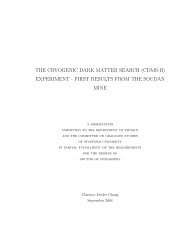Development of a Dilution Refrigerator for Low-Temperature ...
Development of a Dilution Refrigerator for Low-Temperature ...
Development of a Dilution Refrigerator for Low-Temperature ...
- No tags were found...
You also want an ePaper? Increase the reach of your titles
YUMPU automatically turns print PDFs into web optimized ePapers that Google loves.
An obvious demonstration <strong>of</strong> the gravity independence <strong>of</strong> the dilution refrigerator would requirea system many centimeters in diameter to operate properly in all orientations; this, however,is unrealistic. To use capillary <strong>for</strong>ces to control the position <strong>of</strong> the various liquid-liquid and liquidvaporboundaries under an adverse gravitational head <strong>of</strong> many centimeters <strong>of</strong> liquid on the ground,it is necessary to use very fine pores (~5 µm diam.) to contain the liquid. However, we have foundthat such small pores seriously impede the flow <strong>of</strong> dilute He-3 from the mixing chamber to the still;this limits the cooling power achieved and prevents the attainment <strong>of</strong> the temperature goal desired.This need not be a problem <strong>for</strong> a space-based system since the dilution refrigerator can actually usequite large pores to overcome the very small accelerations likely to be encountered in orbit. Theproblem is that it is necessary to test the concept <strong>of</strong> capillary confinement in a dilution refrigeratoron the ground (to at least a limited extent) be<strong>for</strong>e committing to a flight test to provide final confirmation<strong>of</strong> the approach.Shallow Version. We have built a shallow version <strong>of</strong> the dilution refrigerator that has a mixingchamber and still that are only 0.5 cm high; this allows us to use sinter with rather large pores (40µm to 200 µm diam. in different locations, see Fig. 2), which we expect will permit excellentoperation <strong>of</strong> the system. This design can verify a limited amount <strong>of</strong> gravity independence <strong>of</strong> theoperation on the ground. In its normal position with the shallow still next to the shallow mixingchamber, and the pumping line coming out <strong>of</strong> the top <strong>of</strong> the still, it will operate even without sinterin the chambers. It would not continue to operate with the system tilted slightly so that one chamberwas above the other. With the coarse sinter in the chambers, however, we expect to be able totilt the system 5-10 degrees in either direction with little change in operation (see fig. 3). If thesystem is tilted more than this, either one or the other <strong>of</strong> the sinters where the connecting lineattaches becomes empty, stopping the dilute He-3 circulation, or else the He-3 in the mixing chamberescapes into the surrounding small pores, allowing it to leave the mixing chamber.In a more convincing demonstration <strong>of</strong> gravity independence, the chambers can be inverted sothat the still pump line is on the bottom (see fig. 4) and the system should still operate normally.Clearly, no operation in this orientation would be possible without the sinter; the liquid in the stillwould simply run into the pumping line. Even in this orientation the system can be tilted 5-104Still (0.6 K)200 µ pores(copper)80 µ pores(copper)Mixing chamber (0.1 K)He-3Pure He-3 in80 µ pores (copper)Phase boundary(cooling occurs)Dilute He-3 in40 µ pores (copper)Sinter connecting line80 µ pores (stainless steel)Dilute He-3Figure 2. Arrangement <strong>of</strong> different size sinters <strong>for</strong> confining liquid helium in still and mixing chamber.




